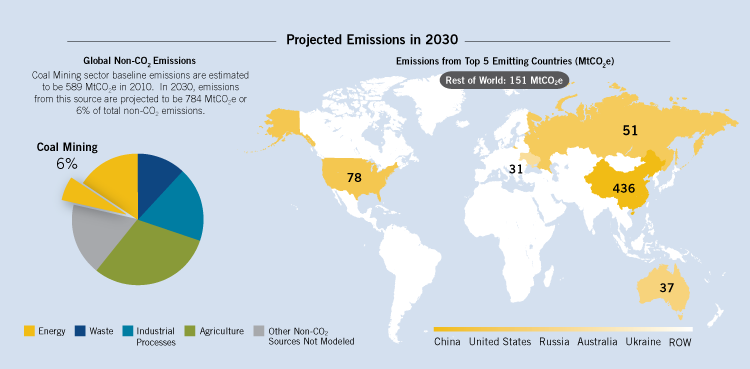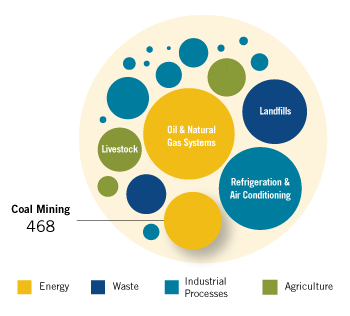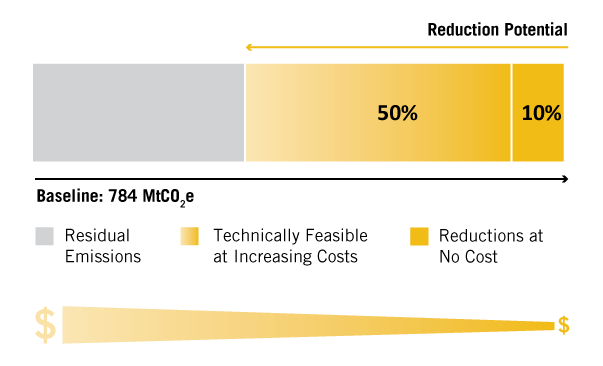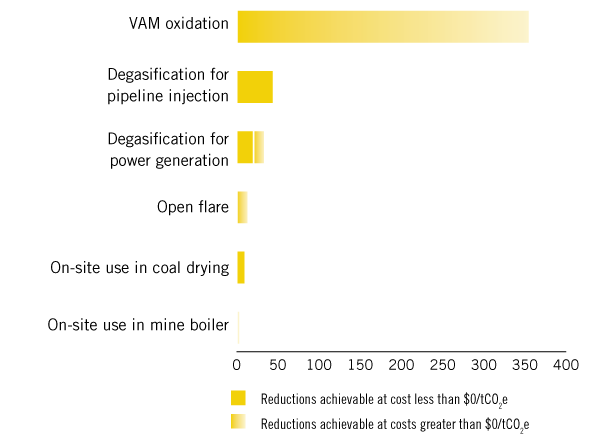Global Mitigation of Non-CO2 Greenhouse Gases: Coal Mining
Key Points
- Coal mining accounted for 8% of total global anthropogenic methane emissions in 2010, and these emissions are projected to increase by 33% to 784 million metric tons of carbon dioxide equivalent (MtCO2e) by 2030.
- The global abatement potential is projected to be 50 to 468 tCO2e, or 6 to 60% of baseline emissions, in 2030. Cost-effective abatement potential ($0 break-even price) is 77.7 tCO2e, or 10% of baseline.
- The technological maximum potential ($100 + break-even price) is 467.6 tCO2e, or 60% of baseline.
Sector Description
Coal is an important energy source for many of the world’s economies; it is used for energy generation or as a feedstock for industrial production. However, coal mining is a significant source of anthropogenic greenhouse gas emissions. Extracting coal through underground and surface mining releases methane (CH4) stored in the coal bed and the surrounding geology. According to the U.S. Energy Information Administration’s most recent international energy outlook, coal production is projected to increase by 22% between 2012 and 2040, reflecting continued economic and industrial development of the world’s emerging economies.
 View or download the full-size image here.(131 K, PNG)
View or download the full-size image here.(131 K, PNG)
Emissions Reduction Potential
Assuming full implementation of current technology, emissions in the coal mining sector could be reduced by up to 468 MtCO2e in 2030. This accounts for 10% of the 4,615 MtCO2e in global reduction potential in 2030.
 View or download the full-size image here. (98 K, PNG)
View or download the full-size image here. (98 K, PNG)
Abatement Potential
Approximately 60% of total annual emissions in 2030 can be reduced through the adoption of the suite of abatement measures considered. The marginal abatement cost curve (MACC) results suggest that significant reductions in CH4 emissions can be achieved at break-even prices at or below $10/tCO2e. Furthermore, reductions of approximately 78 MtCO2e are cost-effectively achievable at a break-even price of $0/tCO2e.
 It would be cost-effective to reduce emissions by 10%, compared to the baseline, in 2030. An additional 50% reduction is available using technologies with increasingly higher costs.
It would be cost-effective to reduce emissions by 10%, compared to the baseline, in 2030. An additional 50% reduction is available using technologies with increasingly higher costs.
View or download the full-size image here.(36 K, PNG)
Abatement Measures
Five abatement measures were considered in this analysis, including recovery for pipeline injection, power generation, process heating, flaring, and catalytic or thermal oxidation of ventilation air methane (VAM). These reduction technologies consist of one or more of the following primary components: 1) a drainage and recovery system to remove methane from the underground coal seam, 2) the end-use application for the gas recovered from the drainage system, and 3) the VAM recovery or mitigation system.
 Emissions reductions by technology in 2030 at $0/tCO2e and at higher prices.
Emissions reductions by technology in 2030 at $0/tCO2e and at higher prices.
View or download the full-size image here.(41 K, PNG)
